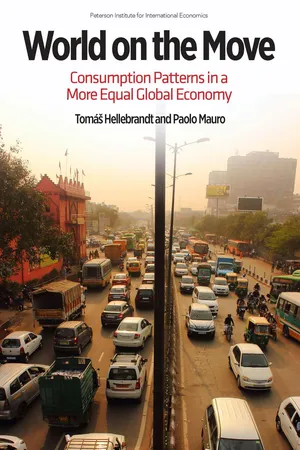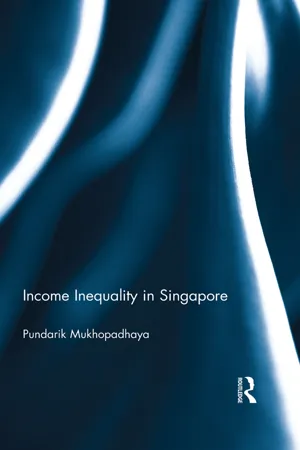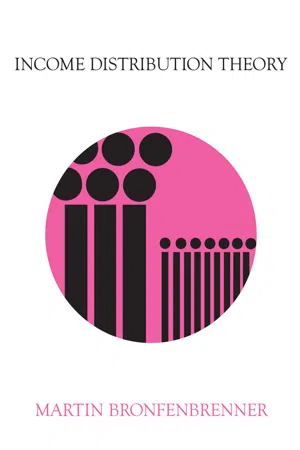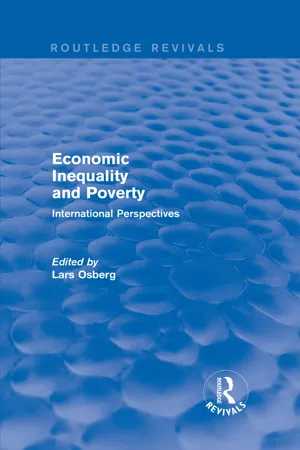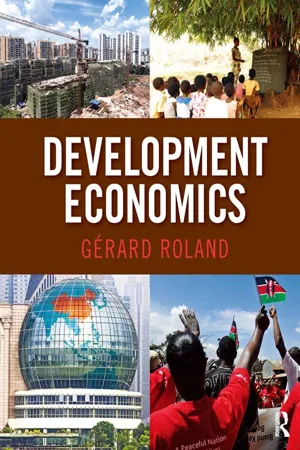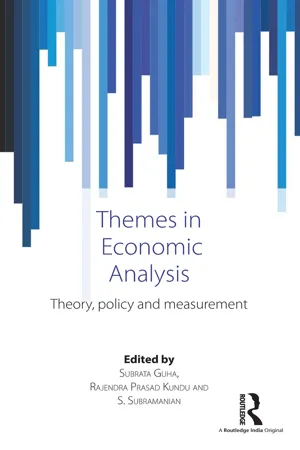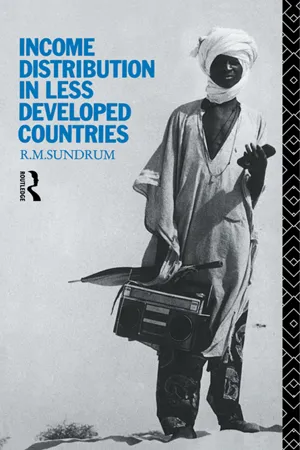Economics
Gini Coefficient
The Gini coefficient is a measure of income or wealth inequality within a population. It is expressed as a value between 0 and 1, with 0 representing perfect equality and 1 representing perfect inequality. A higher Gini coefficient indicates greater inequality, while a lower coefficient suggests a more equal distribution of income or wealth.
Written by Perlego with AI-assistance
Related key terms
Related key terms
1 of 4
Related key terms
1 of 3
11 Key excerpts on "Gini Coefficient"
- eBook - ePub
Development Economics
Theory and practice
- Alain de Janvry, Elisabeth Sadoulet(Authors)
- 2015(Publication Date)
- Routledge(Publisher)
n . The Gini Coefficient can be calculated as:If, for example, incomes in a population of four areyr= {1, 2, 3, 6}, then the Gini Coefficient is:The Gini Coefficient is the most frequently used measure of inequality. It has the inconvenience that two Lorenz curves that cross may have the same Gini. It is also better at characterizing differences in the distribution of income in the middle of the distribution than at the extremes. It has the further inconvenience of not being additively decomposable across subgroups of the population (unlike P α indicators).Table 6.1 Gini Coefficients, income shares, and Kuznets ratios, 2008–11Examples of Gini Coefficients for selected countries are given in Table 6.1 . They show that the Gini Coefficient (expressed in percentage terms) can be low in both very poor countries such as Bangladesh (32) and Ethiopia (34) and very rich countries such as Norway (26, not in the table). It tends to be highest in Latin American countries (e.g. 55 in Brazil, 47 in Mexico), which are mainly middle-income countries.The Theil entropy index :This index runs from 0 (perfect equality) to ln(n ) (maximum inequality). It is often used because it is additively decomposable across population subgroups (see below), a convenient feature when we want to measure how much each population group contributes to total inequality. It has the inconvenience that it cannot be used if there are negative incomes in the population because logs are then undefined.Income shares and Kuznets ratiosA versatile indicator of income inequality is income shares: for example, what is the share of total income held by the richest 20 percent of the population (Table 6.1 - eBook - ePub
World on the Move
Consumption Patterns in a More Equal Global Economy
- Paolo Mauro, Tomas Hellebrandt, Jan Zilinsky(Authors)
- 2016(Publication Date)
This chapter examines how economists measure inequality. It discusses the challenges posed by survey data and explains a novel method of reconciling surveys with national account measures of household consumption. This method results in higher estimates of inequality within countries than indicated by survey data alone. The chapter then discusses recent trends in inequality within countries and the cross-country relationship between inequality and the level of development. The results can be used to inform projections of within-country inequality into the future.How Do Economists Measure Inequality? Key Concepts and IssuesThe most straightforward way of finding out about individuals’ incomes or consumption is to ask them directly. A household survey can provide a good approximation of the distribution of living standards in the population at large, provided that its sample is nationally representative and respondents answer honestly.The Gini IndexSuppose all households participating in a survey are lined up in ascending order of household income. How would one capture the income disparities between them in a single number? Many measures have been put forward over the years, with different properties and varying degrees of relevance, depending on the specific question one is trying to answer (see Cowell 2011 for a discussion).The best-known and most widely used measure of inequality is the Gini index (also referred to as the Gini Coefficient). It is presented by means of the Lorenz curve, which plots the proportion of the total income of the population that is cumulatively earned by the bottom x percent of the population. The Gini index is equal to the ratio of the area (G) between the Lorenz curve and the line of perfect equality to the area of the triangle ABC in figure 3.1 . It takes values between 0 and 100. Perfect equality is achieved when the bottom x percent of the population receives x percent of total income, in which case the Lorenz curve overlaps with the line of perfect equality and the Gini index equals zero. Perfect inequality occurs when all income goes to a single person, in which case the Lorenz curve is ABC in figure 3.1 - eBook - ePub
- Pundarik Mukhopadhaya(Author)
- 2014(Publication Date)
- Routledge(Publisher)
k , the higher the weight given to the lower income group.Kakwani (1986) used Sen’s definition of the Gini Coefficient to propose a generalized version. It can be seen in equation (2.13) that Sen proposed the weightvito depend on rank order of all individuals. To Senvi= (N + 1 − j ). Kakwani introduced a parameter s to define the weightvi= (N + 1 − j )s . Clearly when s =1, the parameter turns out to be the Gini Coefficient and for higher values of s more weight is attached to the lower income group and less weight to the top.The generalized Gini Coefficient has some further normative appeal because of its favourable consideration for the low-income group. However, the mathematical exercise destroys the coefficient’s visual nicety.Welfare-based inequality measures
A convenient approach to measuring the degree of income inequality is the use of a welfare function of income which incorporates normative assumptions concerning the welfare level associated with a certain level of income. The level of welfare corresponds to alternative distributions of the same mean income, and can then be used to derive the degree of inequality. Let W be a fully specified welfare function.44 Following Dalton (1920) a welfare-based equality measure of prevailing distribution can be defined by comparing the actual welfare level W′ with the maximum welfare levelWmax, obtainable with the given total income N̄x of N units with average income ̄x . The associated welfare-based inequality measure can, then, be written as:(A2.2) the measure is defined in the interval [0, 1], clearly the maximum equality is defined as the situation in which the optimum welfare level attainable with income N̄x is reached (in this case value of D is equal to 0). Similarly D approaches 1 (i.e., total inequality) as W′ approaches 0. Thus, D measures the relative welfare loss associated with a prevailing distribution, as compared with the maximum attainable level. To satisfy the homogeneity (mean invariant) principle by the measure D , the welfare function W - eBook - ePub
A New Era
China's Economy Globalizes
- Dexu He, Chaoyang Wang, Dexu He, Chaoyang Wang(Authors)
- 2018(Publication Date)
- Palgrave Macmillan(Publisher)
The Gini Coefficient shown in Table 3.1 is slightly lower than the official data as compared to the official Gini Coefficient shown in Fig. 3.1. This is because the official data were based on microdata from household surveys, and all the total income data were sorted without distinguishing between urban and rural areas, resulting in a more accurate Gini Coefficient. The demographic and other subgroups used in this chapter inevitably concealed the income gap within the group, in addition to the problem of overlap between urban and rural income distributions ; therefore, the findings might be inconsistent with the official data. But overall, the Gini Coefficient measured in Table 3.1 is consistent with the basic trend of the official Gini Coefficient, and the peak appeared roughly at the same time, ensuring that the Gini Coefficient measured in this chapter is credible. Table 3.1 shows that the Gini Coefficient has indeed declined in recent years, which can be explained from the perspective of income sources. As shown in Table 3.1, wage inequality contributed the most to the Gini Coefficient for national total income. The average contribution from 2002 to 2011 was around 62%, and the Gini Coefficient of wage had been slowly declining since 2004. It can be inferred that the decline in wage inequality was the main factor to alleviate the income inequality of residents. The Gini Coefficient and the contribution rate of operational income had been declining throughout the sample period. This shows that the decline in operational income inequality also helped alleviate residents’ income inequality, though to a less extent due its lower share. Unlike the operational income and any other type of income, the Gini Coefficient and the contribution rate of property income showed an upward trend throughout the sample period. This shows that property income inequality had become a major source of worsening income disparities - eBook - ePub
- Martin Bronfenbrenner(Author)
- 2017(Publication Date)
- Routledge(Publisher)
CHAPTER THREETopics in Personal Income Distribution
Statistical Measurement of Inequality
1. To measure the degree of inequality of a personal income distribution—a frequency distribution of incomes by size—we have mentioned two statistics, the standard deviation and the coefficient of variation, defined as the standard deviation divided by the arithmetic mean. (To measure the degree of equality , we could have used the reciprocals of the same statistics.) The attraction of these particular statistics is their simplicity, but they are not widely used in practical work. The coefficient of variation, for example, takes no account of the skewness of the income distribution; it has a lower bound (at zero) but no finite upper bound; and it is influenced by extreme values.Of the infinite variety of conceivable measures of personal income equality and inequality, many of those used in Western Europe and America have been compared and summarized by Bowman.1 The most familiar of these are the Pareto α and the Gini Coefficient of concentration, R . We consider these in order.2. Pareto’s “Law of Income Distribution” appeared in 1897 in his Cours d’économie politique; 2 at that time, supporting statistical data were still widely scattered, unreliable, and difficult to obtain. Pareto’s generalization relates only to the upper tail of the personal income distribution, to values above the mode. Its overall usefulness is reduced by its omission of the lower income brackets.Pareto’s law is in two parts, one relating to the mathematical form of the income distribution’s upper tail and the other to the arithmetical value of one of its coefficients. Let F be a level of income (above the mode), and let N be the proportion of income receivers with incomes equal to or greater than Y - eBook - ePub
Economic Inequality and Poverty: International Perspectives
International Perspectives
- Lars Osberg(Author)
- 2017(Publication Date)
- Routledge(Publisher)
1 The Measurement of Income InequalityStephen Jenkins1. Introduction
In Douglas Adams' science fiction comedy classic The Hitchhiker's Guide to the Galaxy, supercomputer Deep Thought revealed that the Answer to the Ultimate Question of Life, the Universe, and Everything was "42." But unfortunately no one knew what the Question was! Newcomers to the economic inequality literature might justifiably claim to have the opposite problem. There are well-defined important questions—for example, is inequality increasing or decreasing, and by how much?—but what on earth does it mean (if anything) when the Gini Coefficient is 42 percent? The aim of this chapter is to help resolve such problems and thereby provide a theoretical framework for the empirical chapters following.An essential preliminary to any inequality (or poverty) study is clarification of the nature of the distribution to be analyzed to ensure that it represents the appropriate concept of economic power and does so for each constituent unit. Important questions are: What is the economic variable of interest? What is the demographic unit to which this pertains, and how does one ensure variables are comparable across households? These issues are the subject of section 2.The subsequent sections consider inequality measurement per se, focusing on two sorts of Ultimate Question, The first is: under what conditions can one say unambiguously that one distribution is more or less unequal than another? This covers issues such as whether or not inequality has increased over the last decade, is larger in the United States than in the United Kingdom, or whether the post-tax income distribution is more equal than the pretax one. A more demanding requirement is not only the ability to rank the distributions in terms of their inequality, but also to know how much more or less unequal one is relative to the other. On this basis a distinction can be made between ordinal inequality measures (the first case), and cardinal ones (the second). The advantage of the first sort of measures is that the set of basic assumptions underpinning them is smaller than for the second sort—which increases the possibility of having society-wide agreement about their use—but the penalty is that there are situations where unambiguous rankings cannot be made. However, using measures incorporating extra assumptions (the second class) extends the range of potential conclusions that can be drawn. Note that two summary measures may rank a set of distributions in exactly the same way, but represent this using different numerical scales; in this situation the measures are said to be ordinally, but not cardinally, equivalent. - eBook - ePub
- Gerard Roland(Author)
- 2016(Publication Date)
- Routledge(Publisher)
G is thus:G=1−2S.FIGURE 2.3 The Lorenz Curve and the Gini CoefficientThe Gini Coefficient G is equal to twice the area between the diagonal and the Lorenz curve.Figure 2.1 contains information on the quintile distribution of income with the first quintile having 5% of income, the first two having 15%, the first three having 35%, and the first four having 60%, with the richest quintile holding the remaining 40%. The area S is formed from one triangle and four trapezoids. The triangle has an area 0.5(0.2 × 0.05) = 0.005. Recall that the formula of a trapezoid is its base multiplied by half of the sum of its two heights. Given that all four trapezoids have the same base, their area is equal to:0.2[(0.05+0.15)/2+(0.15+0.35)/2+(0.35+0.6)/2+(0.6+1)/2]=0.2(.05/2+0.15+0.35+0.6+1/2)=0.325.S is then equal to 0.325 + 0.005 = 0.33. The Gini Coefficient is equal to 1 − 2 × 0.33 = 0.34. We can calculate Gini Coefficients once we have information on the quantiles of income distribution.Real-world Gini Coefficients. Figure 2.4 provides Gini Coefficients (expressed in percentages between 0 and 100) for a selected group of countries, primarily from 2010, but also from various other years.9 The Gini Coefficients shown in Figure 2.4 take values between 25 for Sweden on the low end, and 59 for Haiti on the high end. Latin American countries, African countries, and China have relatively high income inequality. India’s Gini (33.4) is nearly 10 percentage points lower than that of China (42.5). The United States is among the most inegalitarian wealthy countries with a Gini of 40.8. Russia’s income distribution is roughly that of the United States with a Gini of 40.1. The average for developed OECD countries is around 35. The other countries shown in Figure 2.4 - eBook - ePub
- Robert J. Holton(Author)
- 2014(Publication Date)
- Bloomsbury Academic(Publisher)
It is possible to make some bold judgements about global income inequality about which there is general agreement. The evidence on which these judgements rest is primarily quantitative in form, depending on statistical evidence collected or assembled in a variety of ways. Accurate data is sometimes difficult or impossible to locate, especially for poorer countries lacking the resources to collect adequate data (Jerven 2013). Also the assumptions used in statistical analysis also vary. I shall return to some of these methodological issues later. For the moment, attention is given to four propositions which sum up the general features about which there is most agreement.First, the contemporary world exhibits very high levels of inequality of income and wealth both between countries and within countries. Income is concentrated in the hands of the top 5% of the world’s population who hold 37% of the global income, while the poorest 5% hold only 0.3%. The ratio in income between the top and bottom 5% groups is just short of 200 to 1 (Milanovic 2011, 152). Another way of showing just how high global income inequality has become is to calculate a Gini Coefficient for the world as a whole. The Gini Coefficient, described in Chapter 3 , ranges from 0 (for no inequality) to 100 (highest possible inequality). This measure now stands at around 70 for the world as a whole, making global levels of income inequality higher than the inequality within any single country. Within-country Gini measures vary between 30 and 35 points in most of western Europe, rising to 40+ in the United States, China, and Russia, around 50–55 in Latin America and Africa to around 60 in Brazil and South Africa (ibid. 30–31, 152).These high levels of inequality in income are taken as significant not simply because they limit the consumption of commodities available to individuals, but also because of the negative social consequences of low income levels on other aspects of well-being including health, education, and social participation. Wade (2007, 115) sees income inequality as closely linked with higher poverty, unemployment, crime, worse health, weaker property rights, and skewed access to public services. - eBook - ePub
Themes in Economic Analysis
Theory, policy and measurement
- Subrata Guha, Rajendra Prasad Kundu, S. Subramanian(Authors)
- 2015(Publication Date)
- Routledge India(Publisher)
Part VI Social and Economic MeasurementPassage contains an image
14 On a Family of Indices for Envy in Situations of Income InequalityRavindra Ranade and Yukie ShimonoThe coefficient of inequality in Gini (1912) was initially defined for a finite population—a discrete income distribution. Its calculation was a statistician’s exercise. The income distribution in larger societies, on the other hand, was always thought to be of the lognormal variety. In the literature, including Sen (1973), these two different situations are pooled together by assuming the latter case as an approximation for the former. The lognormal distribution is not very amenable to explicit analysis and manipulability. Making complete sense of the Lorenz curve (Lorenz 1905) and the Gini Coefficient for a continuous distribution is not the easiest of things to achieve for a student exposed to these matters for the first time (see item A1 in the Appendix for some interesting personal history). In this essay, as an approximation, we assume the simplest unimodal income distribution—the triangular one. After all, societies do not have zero and infinity as the extreme incomes as required in the lognormal case. This assumption here allows us to use the minimum level, modal level and the maximum level as parameters for further analysis. The essay is an attempt to propose a family of envy indices based on the Lorenz curve which can be seen to be a quantification of the magnitude of society-wide relative deprivation (or envy) arising from the presence of inequality in an income distribution. In the context of the particular distribution we employ, the index can be related to a number of other elementary statistical measures of central tendency and dispersion.Assumptions and Formal AnalysisWe assume a triangular income distribution with the minimum, modal and maximum income as a$, d$ and b$ respectively—all positive and distinct. Also, the distribution is assumed to be skewed to the left. The density is given by: - eBook - ePub
Social Welfare Functions and Development
Measurement and Policy Applications
- Nanak Kakwani, Hyun Hwa Son(Authors)
- 2016(Publication Date)
- Palgrave Macmillan(Publisher)
1977 ). This study postulates that average income and inequality are the two main determinants of well-being. Well-being increases with average income, but at a decreasing rate. Moreover, the impact of inequality on well-being can either be negative or positive. With this in mind, we estimated income inequality elasticities of well-being using three regression models: one is based on the Gini index, second on the income share of the poorest 40 %, and third on the richest 60 % of the population.Well-being indicators, such as life expectancy at birth, infant survival rate, child survival rate, literacy rate, and completed years of schooling, have lower and upper limits reflecting physical and biological maxima. This means that like income, they cannot go on increasing indefinitely. Moreover, as well-being reaches progressively higher limits, incremental improvement would represent much higher levels of achievement than similar incremental improvements from a lower base. For instance, an increase in longevity from 70 to 75 years will be much harder to achieve than an increase from 50 to 55 years. It becomes increasingly more difficult to increase life expectancy as life expectancy rises.6Given the nature of well-being indicators, estimating elasticities using a linear regression model will be inadequate. The dependent variable varies in a narrow range, which implies a limited variation in the error term giving rise to perverse econometric problems (Kmenta 1990 ). To this end, a non-linear specification may be more appropriate. A popular approach used in the literature is the logistic curve that corresponds to what is known as the logit model. Suppose wel denotes a well-being indicator with lower and upper bounds as m and M, respectively, then a transformed variable given by(6.16)lies in the range between 0 and 1. Following this, we can then introduce the idea of an achievement function:(6.17)which varies from 0 to ∞. Differentiating this equation twice, we obtain and - eBook - ePub
- R. M. Sundrum(Author)
- 2003(Publication Date)
- Routledge(Publisher)
Table 5.7 for some countries where data are available both on the distribution of incomes by income classes and the distribution of consumption expenditures by expenditure classes.The difference between the Gini index of incomes and of consumption expenditures is very small in Bangladesh. This is partly because of the low rate of savings in that country, but it may also be because incomes were reported by households on the basis of their consumption expenditures. The differences are much greater in the Philippines and Sri Lanka. In the case of the Philippines, this may be partly due to a considerable underestimation of incomes compared with consumption expenditures, as noted in section 2.3 .Table 5.6Distribution of labour force by educational qualificationTable 5.7Gini index of distribution of income (Y) and of consumption expenditures (E)The Gini index of the inequality of consumption expenditures can be calculated when the data on the distribution of these expenditures are given for groups of the population classified according to their consumption expenditures. However, in some cases the data on consumption expenditures are only available for groups classified according to their incomes. In these cases the inequality is measured by the concentration ratio of consumption expenditures with respect to income classes. The values of this index are shown in the last column of Table 5.7 . The difference between these concentration ratios and the corresponding Gini indices is quite small in Bangladesh, but much greater in Sri Lanka and the Philippines.In many cases data are available on expenditures of different components of consumption. Then we can calculate measures of inequality of these components, such as the concentration ratios of expenditures on these components with respect to total consumption expeditures. Some illustrative values of these concentration ratios are shown in Table 5.8
Index pages curate the most relevant extracts from our library of academic textbooks. They’ve been created using an in-house natural language model (NLM), each adding context and meaning to key research topics.
Explore more topic indexes
Explore more topic indexes
1 of 6
Explore more topic indexes
1 of 4

